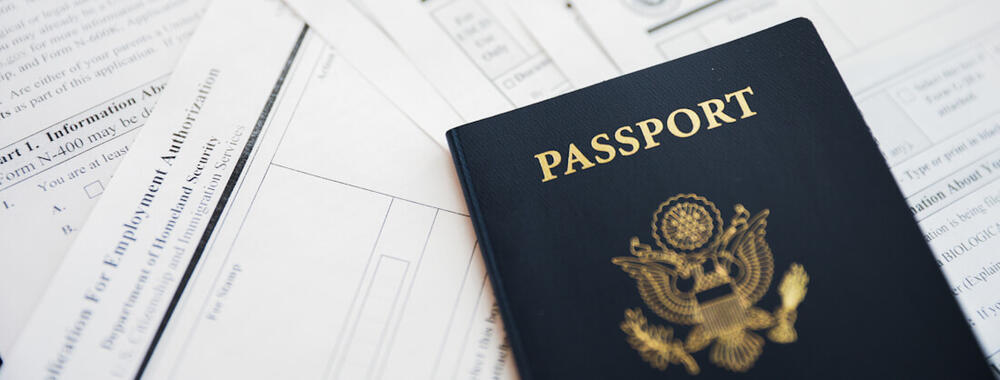- Download our Moving to the USA Guide (PDF)
Securing a work permit for the USA has never been a walk in the park, and major policy shifts in 2025 have thrown a spanner in the works for foreign workers. Most routes rely on employer sponsorship; your prospective boss must petition on your behalf and prove the job ticks specific boxes. Getting a handle on which visa category fits your situation is the first step in cracking this complex system.
Types of work permits for the USA

H-1B visa for speciality occupations
H-1B visas for the USA target professionals in speciality occupations. These roles require you to apply highly specialised theoretical and practical knowledge. You generally need a bachelor’s degree or higher in that specific field to qualify. Common sectors include IT, engineering, finance, architecture, and medicine. Your employer must sponsor the application and demonstrate that the position meets the speciality occupation criteria.
A massive policy shift in September 2025 introduced a USD 100,000 surcharge for new H-1B petitions. This applies if you are outside the USA and do not already hold a valid H-1B visa. The fee effectively walls off the visa for all but the biggest corporate players or the most critical talent. You are exempt if you are already inside the USA in a valid status and filing for a change of status, extension, or change of employer.
Exceptions are scarce. The Secretary of Homeland Security must find that your presence serves the national interest and that no US worker is available. They must also prove the fee would undermine US interests. Apart from the fee, these visas still face annual caps of 65,000 (plus 20,000 for those with US master’s degrees).
If approved, H-1B visas are typically granted for an initial period of three years and can be extended for a total of six years. Standard processing often drags on for months, but you can pay for premium processing to get a faster answer. You can bring your spouse and unmarried children under 21 on H-4 dependant visas. H-4 spouses may be eligible for work authorisation if the H-1B holder has an approved I-140 immigrant petition or has been granted H-1B status beyond the six-year limit.
L-1 visa for intracompany transfers
The L-1 visa for intracompany transfers targets employees of international firms moving to a US branch, subsidiary, or affiliate. You must have worked for the company abroad for at least one continuous year within the last three.
The visa is divided into two categories: L-1A for executives and managers, valid for up to seven years, and L-1B for employees with specialised knowledge of the company’s products, services, or processes, valid for up to five years.
While proprietary knowledge helps, the US Citizenship and Immigration Services (USCIS) does not require the knowledge to be unique. It simply must be demonstrably more sophisticated than what a skilled worker gains through ordinary experience. Your employer can file an individual L-1 petition. If eligible, they might use a blanket L petition to speed things up.
You can bring your spouse and unmarried children under 21 on L-2 dependant visas. L-2 spouses enjoy work authorisation incident to their status. This means they can work immediately upon entry without battling the bureaucracy for a separate Employment Authorization Document. The L-1A visa also offers a relatively straight path to permanent residence through the EB-1C category for multinational executives.
O-1 visa for individuals with extraordinary ability
Reserved for those at the top of their game, the O-1 visa for individuals with extraordinary ability covers sciences, arts, education, business, athletics, and film or TV. You need hard evidence of sustained national or international acclaim. This can include receipt of major prizes or awards, published material about you in professional publications, membership in associations requiring outstanding achievement, evidence of your high salary relative to others in the field, or other comparable evidence demonstrating extraordinary ability.
While the evidentiary requirements are demanding, the O-1 visa has no annual cap. It serves as a solid alternative to the H-1B for highly accomplished professionals. Initial approval usually lasts up to three years to cover the time needed for your specific event. Extensions are available in one-year increments as long as you continue working in your field. Your employer or agent must sponsor the petition.
E-2 Treaty Investor visa
Nationals of countries with qualifying treaties (such as the UK, Canada, Australia, Japan, and many European states) can use the E-2 Treaty Investor visa to invest in and direct a US business. Your investment must be substantial relative to the cost of buying or creating the enterprise. The funds must be committed and at risk. You must actively develop and direct the business.
Unlike many other permits, the E-2 is strictly a non-immigrant visa and does not directly lead to a Green Card. You can renew it indefinitely in two-year increments as long as the business remains operational and fits the bill. This suits entrepreneurs wanting a long-term US presence without necessarily pursuing permanent residence.
TN visa for Canadian and Mexican professionals
Under the United States-Mexico-Canada Agreement (USMCA), the TN visa for Canadian and Mexican professionals allows citizens of those countries to work in the USA. There is a specific list of qualifying professions, including accountants, engineers, lawyers, scientists, teachers, management consultants, computer systems analysts, and many others in scientific, technical, and professional fields. Requirements are generally looser than H-1B visas, and there are no annual caps. Canadians can usually get TN status right at the border. Mexican citizens do not have this luxury and must apply for a TN visa at a US consulate.
Other work visas
Several other work visas for the USA fill specific niches:
- The E-1 Treaty Trader visa suits those engaged in substantial trade, principally between the USA and their treaty country.
- The H-2A and H-2B visas cover temporary agricultural and non-agricultural workers.
- The J-1 visa applies to exchange visitors in educational and cultural programmes approved by the US Department of State.
Applying for a work permit for the USA

Your employer usually shoulders the burden of the work permit application for the USA, although you must provide the necessary paperwork. Generally, your employer files a petition with the USCIS using Form I-129 (Petition for a Non-immigrant Worker). This applies whether you are requesting a change of status from within the USA or waiting for approval before applying for a visa stamp at a US consulate abroad.
Documentation varies by category but usually includes:
- proof of your qualifications, such as diplomas and transcripts;
- letters from previous employers verifying your experience and job descriptions; and
- evidence that the position meets the visa criteria and constitutes a valid employer-employee relationship.
For H-1B visas, your employer must first secure a certified Labour Condition Application (LCA) from the Department of Labour. This document attests to wages, working conditions, and compliance with programme rules.
Processing times fluctuate wildly based on the visa type and service centre. Standard processing can drag on for months, whereas premium processing guarantees a response within 15 business days. Get your ducks in a row early, especially for visas involving caps or lotteries.
Once approved, you must keep working for your sponsoring employer to maintain your status. If you change employers, the new employer must file a fresh petition using Form I-129. H-1B holders can start working for a new employer once USCIS receives the transfer petition, although final approval is still necessary. Consult an immigration lawyer before making changes that could jeopardise your status.
Family members can typically accompany you on dependant visas. Work rights vary:
- L-2 and E-2 spouses have work authorisation incident to status.
- H-4 spouses might be eligible for work authorisation under specific conditions.
- O-3 dependants cannot work in the United States.
Green Cards and permanent residence in the USA
While Green Cards and permanent residence in the USA are the ultimate goal for many, work permits only allow temporary employment. Employment-based Green Cards fall into five preference categories (EB-1 through EB-5). Processing times depend heavily on your nationality and the current visa bulletin; for most, it spans two to four years, but it can take significantly longer.
Useful links
- US Citizenship and Immigration Services: Temporary Non-Immigrant Workers
- US Department of State: Temporary Worker Visas
- US Citizenship and Immigration Services: Working in the United States
Visa regulations are subject to change at short notice, and you should contact your respective embassy or consulate for the latest details.
